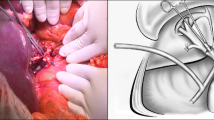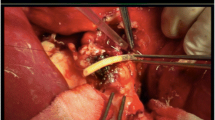Abstract
T-tube-related bile leakage is a considerable problem in liver transplantation but rather rare in surgery of biliary lithiasis. To investigate the effect of T-tube insertion method and material on the intraperitoneal T-tube tract, we performed a choledochotomy and insertion of a T-tube (four of silicone, seven of latex, four of silicone with a latex sheath around the long arm) for 2 weeks on 15 piglets (choledochotomy group), and sutured a transected bile duct over a T-tube stent in nine piglets (five silicone, four latex), inserted similarly as in liver transplantations, for 6 weeks. Sixteen patients underwent cholectochotomy and T-tube drainage with a latex T-tube (n = 8) and latex-sheathed silicone T-tube (n = 8) for a median 9 (7–21) days. Histological examination of T-tube tracts in piglets was made, and complications after T-tube removal in the latex T-tube group were compared with those in the latex-sheathed silicone T-tube group. In piglets, latex T-tubes induced better tracts than silicone T-tubes (P < 0.05). Piglets in the choledochotomy group had tracts superior to those in the anastomotic stent group (P < 0.05). There was one bile leakage in the latex T-tube group, and none in the latex-sheathed silicone T-tube group. We conclude that T-tube tract development is affected by both the material and the insertion method of T-tubes. A silicone T-tube with a latex sheath around the long arm may also be a good choice for T-tube material in liver transplantation.
Similar content being viewed by others
References
Moreno P, Biondo S, Recaj M (1992) Biliary reconstruction without T tube in OLT (abstract). LICAGE, Rome
Osorio RW, Freise CE, Stock PG (1993) Nonoperative management of biliary leaks after orthotopic liver transplantation. Transplantation 55:1074–1077
Vaccaro JF, Dorffman GS, Lambiase RE (1991) Treatment of biliary leaks and fistulae by simultaneous percutaneous drainage and diversion. Intervent Radiol 14:109–112
Sherman S, Shaked A, Cryer H (1993) Endoscopic management of biliary fistulas complicating liver transplantations and other hepatobiliary operations. Ann Surg 218:519–524
O’Connor T, Lewis W, Jenkins R (1995) Biliary tract complications after liver transplantation. Arch Surg 130:312–317
Klein AS, Savander S, Burdick JF (1991) Reduction of morbidity and mortality from biliary tract complications after liver transplantations. Hepatology 14:818–823
Krom R, Kingma L, Haagma L (1985) Choledochostomy, a relatively safe procedure in orthotopic liver transplantation. Surgery 97:552–556
Porcheron J, Boillot O, Ponchon T (1994) Treatment of bile leakage after T-tube re-moval in liver transplantations. Ann Chir 48:441–445
Corbett CRR, Fyfe NCM, Nicholls RJ, Jackson BT (1986) Bile peritonitis after removal of T-tubes from the common bile duct. Br J Surg 73:641–643
Eggert A, Luetkens S (1986) Gallige Peritonitis nach T-drain-Entfernung. Chir Praxis 36:33–39
Glättli AA (1994) Supraduodenal choledochotomy. In: Blumgart H (ed) Surgery of the liver and biliary tract, 2nd edn. Churchill-Livingstone, London, pp 647–659
Holla RK, Sequirea RP, Kulkarni DR (1988) Cyclosporine and wound healing: diffe-rential effect on tensile strength, granuloma weight, wound contraction and epithelialization period in rats. Ind J Exp Biol 26:869–873
Sugiyama M, Atomi Y, Kuroda A, Muto T (1993) Treatment of choledocholithiasis in patients with liver cirrhosis. Surgical treatment or endoscopic sphincterotomy? Ann Surg 218:68–73
Apalakis A (1976) An experimental evaluation of the types of material used for bile duct drainage tubes. Br J Surg 63:440–445
Rolles K, Kieran D, Noveli R (1994) Biliary anastomosis after liver transplantation does not benefit from T-tube splintage. Transplantation 57:402–404
Author information
Authors and Affiliations
Rights and permissions
About this article
Cite this article
Koivusalo, A., Eskelinen, M., Wolff, H. et al. Development of T-tube tracts in piglets: effect of insertion method and material of T-tubes. Res. Exp. Med. 197, 53–61 (1997). https://doi.org/10.1007/s004330050055
Received:
Accepted:
Published:
Issue Date:
DOI: https://doi.org/10.1007/s004330050055




